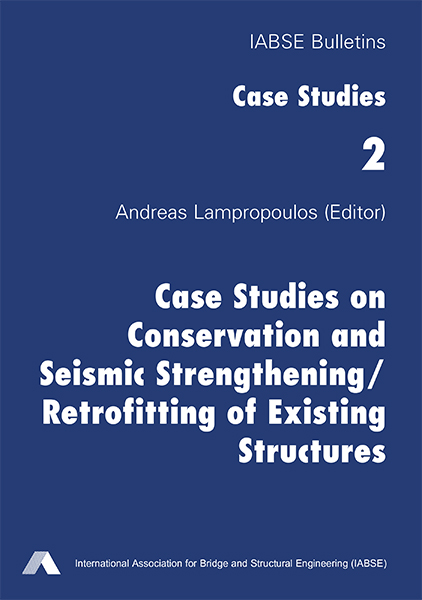Case Studies on Conservation and Seismic Strengthening/Retrofitting of Existing Structures

|
|
|||||||||||
Bibliographic Details
| Editor(s): |
Andreas Lampropoulos
(University of Brighton)
|
||||
|---|---|---|---|---|---|
| Medium: | book | ||||
| Language(s): | English | ||||
| Publisher: | International Association for Bridge and Structural Engineering (IABSE) | ||||
| Published in: | Zurich, Switzerland | ||||
|
|||||
| Page(s): | 210 | ||||
| Total no. of pages: | 226 | ||||
| Year: | 2020 | ||||
| ISBN-10: | 3857481730 | ||||
| ISBN-13: | 978-3-85748-173-4 | ||||
| DOI: | 10.2749/cs002 | ||||
| Series: | IABSE Bulletins - Case Studies (No. 2) | ||||
| Cover: | soft-cover (paper binding) | ||||
| Notes: |
Recent earthquakes have demonstrated that despite the continuous developments of novel materials and new strengthening techniques, the majority of the existing structures are still unprotected and at high seismic risk. The repair and strengthening framework is a complex process and there are often barriers in the preventative upgrade of the existing structures related to the cost of the applications and the limited expertise of the engineers. The engineers need to consider various options thoroughly and the selection of the appropriate strategy is a crucial parameter for the success of these applications. The main aim of this collection is to present a number of different approaches applied to a wide range of structures with different characteristics and demands acting as a practical guide for the main repair and strengthening approaches used worldwide. This document contains a collection of nine case studies from six different countries with different seismicity (i.e. Austria, Greece, Italy, Mexico, Nepal and New Zealand). Various types of structures have been selected with different structural peculiarities such as buildings used for different purposes (i.e. school buildings, town hall, 30 storey office tower), a bridge, and a wharf. Most of the examined structures are Reinforced Concrete structures while there is also an application on a Masonry building. For each of the examined studies, the local conditions are described followed by the main deficiencies which are addressed. The methods used for the assessment of the in-situ conditions also presented and alternative strategies for the repair and strengthening are considered. |
||||
| Purchase from: | |||||
| Copyright: | © 2020 International Association for Bridge and Structural Engineering (IABSE) | ||||
| License: | This creative work is copyrighted material and may not be used without explicit approval by the author and/or copyright owner. |
||||
Articles
| Author(s) | Title | Page(s) |
|---|---|---|
| Dritsos, Stephanos | Modification and Strengthening of a Characteristic Reinforced Concrete Building in Patras, Greece | 21-41 |
| Dumaru, Rakesh | Seismic Performance Assessment, Retrofitting and Loss Estimation of an Existing Non-Engineered Building in Nepal | 43-70 |
| Giarlelis, Christos | Seismic Rehabilitation of a School Building in Cephalonia, Greece | 1-20 |
| Jara, José M. | Strengthening and Retrofitting of Motín de Oro II Bridge in Mexico | 193-209 |
| Martinelli, Enzo | Retrofitting of School Building Located in Southern Italy | 71-94 |
| Morris, Gareth | Christchurch Town Hall Complex: Post-Earthquake Ground Improvement, Structural Repair, and Seismic Retrofit | 145-172 |
| Presland, Rob | Thorndon Container Wharf: Temporary Works for Recovery of Container Operations (New Zealand) | 127-144 |
| Stefanoudakis, Dimitrios | Strengthening and Modernization of a Characteristic Masonry Building in Vienna, Austria | 173-192 |
| White, Joe | Seismic Strengthening of the Majestic Centre, Wellington, New Zealand | 95-126 |
